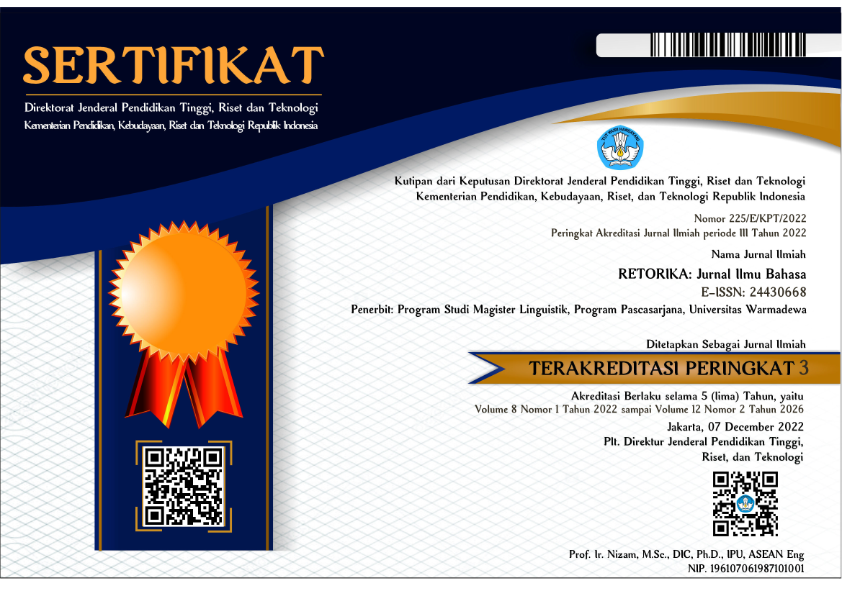Fishery Ecolexicon in Kambera
Abstract
This research is a qualitative descriptive study that aims to study and describe the ecolexicon that represents the fisheries sector in Waingapu using ecolinguistics theory. This theory emphasizes the reciprocal relationship between language and the environment. The data collection methods used are in-depth interviews and observation. Data are analyzed using the padan method, specifically teknik pilah unsur penentu (the determinant element sorting technique). Informants are people who live and work in the fisheries sector, such as fishermen, fishmongers, and fishery practitioners. Data analysis shows that there are lexicons in Kambera related to the fishery sector which consists of nouns and verbs from the point of view of lexical categories. Nouns dominate the list and contain most of the names of fishery products such as fishes, crabs, clams, and others. Besides, it also consists of terms of fishing equipment. For verbs, they are related to fishing activities.
References
Budhiono, R. H. (2017). Leksikon Alat Dan Aktivitas Bertanam Padi Dalam Bahasa Jawa. Kandai, 13(2), 235. https://doi.org/10.26499/jk.v13i2.210
Bura, B. (2016). Penggunaan Leksem Burung Dalam Peribahasa Sikka : Kajian Sosiolinguistik. KEMBARA: Jurnal Keilmuan Bahasa, Sastra, Dan Pengajarannya, 1(3), 1–11.
Chaer, A. (2008). Morfologi Bahasa Indonesia. Rineka Cipta.
Fauzi, A. (2016). Ekoleksikon Kelautan Masyarakat Nagari Air Bangis, Kecamatan Sei Beremas, Kabupaten Pasaman Barat [Universitas Sumatera Utara]. https://www.usu.ac.id/id/fakultas.html
Fill, A., & Muhlhausler, P. (2006). Ecolinguistics Reader: Language, Ecology and Environment. Continuum.
Finegan, E. (1999). Language: Its Structure and Use (3rd edition). Thomson Wadsworth.
Holland, G. J., Greenstreet, S. P. R., Gibb, I. M., Fraser, H. M., & Robertson, M. R. (2005). Identifying sandeel Ammodytes marinus sediment habitat preferences in the marine environment. Marine Ecology Progress Series, 303(January 2014), 269–282. https://doi.org/10.3354/meps303269
Kamus Besar Bahasa Indonesia. (2016). In kbbi.kemendikbud.go.id. Badan Pengembangan dan Pembinaan Bahasa, Kementerian Pendidikan dan Kebudayaan Republik Indonesia. https://kbbi.kemdikbud.go.id
Kinakesti, S. M., & Wahyudewantoro, G. (2017). Kajian jenis ikan pari (Dasyatidae) di Indonesia. Fauna Indonesia, 16(2), 17–25. https://journal.unnes.ac.id/nju/index.php/JM/article/view/2970/3006
Kridalaksana, H. (1984). Kamus Linguistik. Gramedia Pustaka Utama.
Lindø, A. V., & Bundsgaard, J. (eds. . (2000). Dialectical Ecolinguistics. Nordisk Institut.
Mahsun. (2017). Metode Penelitian Bahasa. In Fakultas Adab dan Humaniora UIN Sunan Ampel Surabaya. Ar-Ruzzmedia.
May, S., & Hornberger, N. H. (2008). Language Policy and Political Issues. In N. H. Hornberger (Ed.), Springer Reference (2nd ed.). Springer. http://eprints.lancs.ac.uk/1573/
Mbete, A. M. (2013). Penuntun Singkat Penulisan Proposal Penelitian Ekolinguistik. Vidia.
Mbete, A. M., Putra, A. A. P., Yadnya, I. B. P., Simpen, I. W., Genua, V., & Utami, G. W. N. (2015). Khazanah Ekoleksikal Guyub Tutur Bahasa Lio, Flores.
Meiyasa, F., & Tarigan, N. (2021). Keanekaragaman Jenis Makroalga yang Ditemukan di Perairan Wula-Waijelu Kabupaten Sumba Timur. Quagga: Jurnal Pendidikan Dan Biologi, 13(2), 60–67. https://doi.org/10.25134/quagga.v13i2.3749
merriam-webster.com. (2022). Merriam-Webster Dictionary. https://www.merriam-webster.com
Oktaviyani, S. (2018). Mengenal Marga Lutjanus, Salah Satu Komoditas Unggulan Dalam Perikanan Tangkap. Oseana, 43(3), 29–39. https://doi.org/10.14203/oseana.2018.vol.43no.3.61
Pulukadan, I., Keppel, R. C., & Gerung, G. S. (2013). A Study on Bioecology of Macroalgae, Genus Caulerpa in Northern Minahasa Waters, North Sulawesi Province. Aquatic Science & Management, 1(1), 26. https://doi.org/10.35800/jasm.1.1.2013.1965
Putra, W., Widayati, D., Dardanila, D., & Amanda, S. (2021). Leksikon kegulmaan pada masyarakat Jawa di Perkebunan Fajar Agung, Kecamatan Pegajahan, Kabupaten Serdang Bedagai: Kajian ekolinguistik. KEMBARA Journal of Scientific Language Literature and Teaching, 7(1), 198–215. https://doi.org/10.22219/kembara.v7i1.15432
Sidu, N. (2017). Ekoleksikon Ke-Kaghati-An Bahasa Muna. RETORIKA: Jurnal Ilmu Bahasa, 2(2), 328. https://doi.org/10.22225/jr.2.2.64.328-349
Simpen, I. W., Yadnya, I. B. P., Mbete, A. M., Putra, A. A. P., Utami, G. W. N., & Adni, N. P. (2015). Fungsi Sosial Budaya Bahasa Lio, Flores.
Sinaga, J., I Wayan Simpen, & Made Sri Satyawati. (2021). Khazanah Ekoleksikon Kedanauan Dalam Guyub Tutur Bahasa Batak Toba. KULTURISTIK: Jurnal Bahasa Dan Budaya, 5(1), 1–7. https://doi.org/10.22225/kulturistik.5.1.1976
Utami, E., Prasetiyono, E., Rendy, Iskandar, T., & Isnawati, E. P. (2022). Tampilan Pengembangan Budidaya Ikan Belanak Belinyu di Kecamatan Belinyu, Kabupaten Bangka. Jurnal Pengabdian Masyarakat Indonesia, 2(1), 67–76. http://jpmi.journals.id/index.php/jpmi/article/view/442/63
Copyright (c) 2023 RETORIKA: Jurnal Ilmu Bahasa

This work is licensed under a Creative Commons Attribution-ShareAlike 4.0 International License.
This journal provides immediate open access to its content on the principle that making research freely available to the public supports a greater global exchange of knowledge.
All articles published Open Access will be immediately and permanently free for everyone to read and download. We are continuously working with our author communities to select the best choice of license options, currently being defined for this journal as follows: Creative Commons-Non Ceomercial-Attribution-ShareAlike (CC BY-NC-SA)
 Abstract viewed = 79 times
Abstract viewed = 79 times
 PDF downloaded = 131 times
PDF downloaded = 131 times

2.png)














